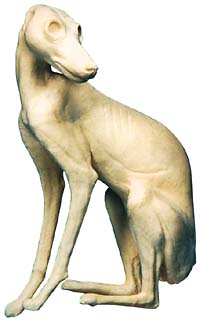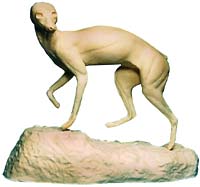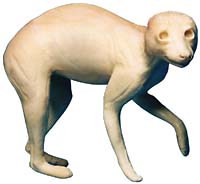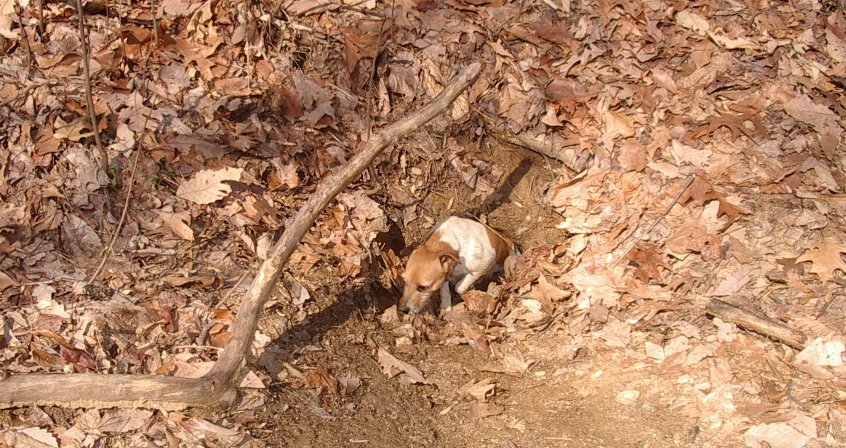Out
of the Ring
and Into the Den
Very few Kennel Club
terriers actually hunt. Here's why.
Red Fox
Wasco Taxidermy Mount Manikin, 14 inch chest
"Was she the runt of the
litter?"
I look up to see a slightly overweight woman walking her
dog around the edge of a grassy parking area.
"No, ma'am. She's a hunting Jack Russell -- they're
bred this size to do earth work."
"Oh yes," she sniffed, "groundhog holes
are so small. Noodle's wasn't bred for that - her type
were bred to go after red fox."
I look down the leash. There sits a solid dog with
thick legs, a cinder-block head, and a chest bigger than
a mailbox, a very happy look on its face.
"Yes ma'am," I reply. "That's what they
say. Noodles sure looks like a happy dog. How old is
she?"
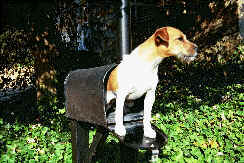
A
working dog should fit inside a
mailbox, not have a chest as big as one.
Some variation of this conversation invariably takes
place when I go to an AKC go-to-ground trial with my two
terriers - a small female Jack Russell and a large male
Border Terrier.
At one time or another in these conversations, I have
been told that hunting terriers need long legs to
"follow the horses" and that "short legs
are needed for a dog to be able to go to
ground." I have been told that certain breeds
have huge heads and jaws "in order to kill
badgers," and that dramatically elongated heads
"set the eyes far enough back that they can't be
bitten by a fox." I have been told that
"colored dogs will get ripped up by fox
hounds," and that the solid coated Border terrier is
"the last true hunting terrier." And
again and again I have been told that, "the British
fox is much larger than the ones we have here in
America".
I listen, but I don't believe much of it anymore.
In truth, very few terrier owners hunt their dogs, and
most terrier owners have never seen a fox much less a fox
den. In this increasingly urban world it is a lucky
accident if the average terrier manages to nail a rat,
field mouse or mole. Such accidental take is not the
specialized work that terriers were bred to do,
however. As Captain Jocelyn Lucas notes in Hunt
and Working Terriers (1931): "Working
terriers means, in sporting parlance, a terrier that will
go to ground on fox, badger, or otter, and not merely a
dog that will kill rats or hunt out
rabbits."
Badger and otter hunting with terriers has been illegal
in England for nearly 30 years, however, and it looks
like fox hunting will soon follow. If Jocelyn Lucas
were alive today, he would be standing in a visa line
waiting to come to the U.S., where red fox, gray fox,
groundhog, possum and raccoon are in abundance and where
badger and nutria can also be worked in some
states.
If you want to hunt in America, all you need is a proper
dog.
A Proper Dog
A "proper dog," of course, is harder to get
than it sounds.
For one thing, almost all the dogs you see at Kennel Club
shows are too big to actually work. In fact, this
appears to be true in Great Britain as well where most
hunt terriers are small ununregistered Jack Russells,
patterdale-type fell terriers, crosses, or dogs of
“pedigree unknown.” The naturally small
Kennel Club breeds that do exist rarely see hunt service
as they are likely to have other failings as far as the
hunter is concerned -- lack of gameness, lack of nose,
lack of voice, or lack of judgment, to name just four
common faults.
While nose, voice, gameness and judgment are all
important attributes of a working terrier, no attribute
is more critical than size.
If a dog cannot get down a hole, nothing else matters.
Perversely, however, while size is the one characteristic
of a hunting terrier that is easily measurable in the
show ring, it is also the one attribute of a working
terrier that is most shrouded in misrepresentation and
ambiguity.
Consider the Border Terrier, for example: the
American Kennel Club standard for the breed says
"the body should be capable of being spanned by a
man's hands behind the shoulders."
This is a ridiculously imprecise measurement. Which man's
hands? Does this mean there can be no women
judges? And if the average man can span a 19-inch
dog, does this mean such a dog is actually capable of
going to ground in a natural earth? Finally, if the
standard for the Border Terrier is supposed to reflect
the requirements of a working dog, why is the entire
shoulder and chest area of the Border Terrier – a
clear determinant of whether a dog can actually go to
ground -- afforded only 10 points out of a possible
100?
Walter Gardner, in his book, About the Border Terrier,
notes that “the earlier border, which was bred for
work rather than exhibition, was certainly smaller than
many borders we see today,” and describes Jacob
Robson’s Flint, one of the most famous working
border terriers, as weighing just 12 pounds.
The typically show-ring border terrier we see today
weighs half again as much and has a chest span of about
17 inches.
The fact that chest span is given such short shrift in
the show ring is hardly surprising when one considers
that many people think a dog has proven its worth if it
can merely shove its head and shoulders into a den
entrance.
In fact, a true working dog should be able to enter a fox
den or groundhog sette and negotiate the entire pipe
– from main entrance to bolt hole -- without having
to be dug out of the ground. In a natural earth
this den pipe will be 15 to 40 feet long and will rise
and fall, twist and contract, challenging the dog at
every turn.
A dog that routinely fails this challenge is not a useful
dog. In fact, hunting with a large dog that cannot
get past the first turn is nearly impossible, as it
requires a team of diggers to sink a new hole whenever
the tunnel changes direction, and in the end you may end
up excavating the entire length of the den.
A large dog in a small hole is also a danger to
himself. A terrier that has to dig hard in order to
move up a tunnel is a dog that has to push dirt behind it
in order to make progress. As earth is shoved to
the rear, a dirt wall can easily form just behind the
dog, "bottling" it off from its air
supply. Because a digging dog is working hard and
breathing hard (as is the quarry) asphyxiation
underground is a very real possibility.
A small dog, on the other hand, can simply scoot over
small dirt mounds and around constrictions and
obstacles. Not only will such a dog face the quarry
with more energy and more air, it will also have room to
maneuver to avoid a bite and force a bolt. A larger
dog, on the other hand, may find itself face to face with
the quarry, jammed tight in the pipe, already tired, and
with a dwindling air supply. Only tragedy can come
out of such a situation.
A Fox is Not a Coyote
Ken James, who hunts his Wills View pack of Jack Russell
terriers in the mountains and farm country of Western
Pennsylvania, has measured the chest size of a wide range
of terrier quarry. His conclusion is that any dog
with a chest larger than 14 inches around is going to
have a very difficult time.
Quarry
Average Chest Size
Smallest Chest Size
Number Measured
Groundhog 14 inches
12 inches
65
Red Fox
13 inches
11.5 inches
6
Gray Fox
12.5 inches
10.5 inches
10
Raccoon
14.5 inches
11 inches
30
Measurement from Ken James' book:
Working Jack Russell Terriers in North America: A Hunter's Story
What is fascinating about these measurements is how
clearly they demonstrate a simple fact: the chest
size of the red fox (Vulpes vulpes) is almost exactly the
same as that of the North American groundhog or woodchuck
(Marmota monax).
Many Kennel Club terrier owners find this hard to
believe, and some argue that the fox dens they have seen
have larger entrances than the average groundhog
sette.
This last point is true, but only for the first three or
four feet of a red fox den. Here, at the front
entrance, the fox excavates the groundhog hole into a
vertical oval so that it can bolt out of the den at a
trot. Farther back from this first three or four
feet of excavation, however, a groundhog sette is
generally left as it was found, with a fox able to exit
the same carefully disguised bolt hole the groundhog once
provided for himself.
Gray
Fox
Wasco Taxidermy Mount Manikin, 14 inch chest
When confronted with measurements of American red fox
chests, some American terrier owners will argue that the
North American red fox is a different species than its
European counterpart and therefore must have a smaller
den.
This is simply not so.
The red fox is an import, brought to the United States in
the 1600s because the native gray fox would climb trees
when chased by men on horses. British redcoats,
anxious to continue their fox hunting tradition in the
New World, brought with them the quarry they required for
their sport, and the red fox flourished as forests fell
to fields. Not only are there more red fox in
America today than at any other point in history, there
are also more groundhogs, more gray fox, more raccoon and
more possums – all due to changing habitat which
worked to encourage more of these agricultural
opportunists.
In both England and the United States the size of the red
fox is quite variable, with larger animals generally
found in the north, and smaller animals in the
south. In The Working Terrier British
terrierman D. Brian Plummer notes that he has caught fox
as small as 6 pounds and as large as 20 pounds but that
"the average weight for adult fox is roughly 14
pounds, and vixens are usually smaller than
dogs."
In his book, How to Spot a Fox, J. David Henry
notes that the average adult red fox in the U.S. ranges
from 5.5 to 12 pounds in southern states and between 11
and 20 pounds in northern states. Henry reports
that in Great Britain the red fox ranges from 11 to 16.5
pounds for dogs and from 10 to 14.5 pounds for
vixens.
In short, the British and American red fox are exactly
the same creature and they are exactly the same size,
with foxes on both continents having a mean size of 10 to
14 pounds.
It should be said that a 12-pound fox is not built like a
14-pound dog, but like a 12-pound tabby, with a tiny
chest, and bones that seem almost elastic. Fox
biologist J. David Henry, in fact has entitled one of his
books, Red Fox: The Catlike Canid in order to
stress both the morphological similarity of the cat and
the fox, and their nearly parallel hunting styles.
A 14-pound dog will find it difficult to follow a 10 or
12-pound fox to ground in a tight earth because, in all
likelihood, a dog this large will have a chest that is at
least 2 inches too big.
The dog you need in the field has a chest span of under
14 inches and will probably stand little more than 12
inches tall at the shoulder and weigh in at 9 to 12
pounds – a mere shadow of the dogs we typically see
winning in the show ring.
A dog this small can follow a fox to ground and negotiate
the average groundhog den with relative ease – they
are, after all the same-sized sette.
This last fact seems to disappoint some terrier
owners. Perhaps this is due to the anglophile
streak we see among many terrier owners – a
glorification of all things British, with a latent
suggestion that American dogs and American quarry
must somehow be inferior. The royalist image of
wealthy redcoats riding to fox is, after all, more
attractive than that that offered by the American
terrierman slogging through pastures dressed in overalls
with a sharp spade over one shoulder.
That said, the terriers needed by both parties are
exactly the same, and a proper dog for red fox is also a
proper dog for groundhog, gray fox, and raccoon.
The fact that the majority of Kennel Club dogs on both
continents cannot make it in the field has less to do
with changing quarry or changing geography than it does
with show ring standards that cloud the issue of size
while at the same time giving the bulk of all show ring
points to such non-essential characteristics as eye
color, nose color, the lay of the ears and the carriage
of the tail.
The good news is that even as England and Scotland move
to ban fox hunting with dogs, hunting with terriers is
beginning to take hold here in America.
While the best days of the British working terrier may
lay in the past, the best days of the American working
terrier lie immediately ahead. Those that would
prefer to work their dogs in the real world, rather than
fantasize about the nature of working dogs in a far off
land, need only find a small terrier out of working stock
to start their journey.
Raccoon
Wasco Taxidermy Mount Manikin
16 inch chest_____________________________________
FOX DENS OF THE WORLD
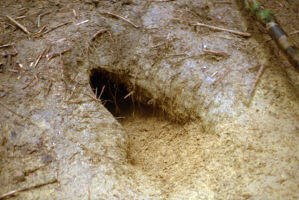 This is a picture of a fox den in
Australia made out of an enlarged rabbit hole cut in a
railway embankment. Note the oval shape where the fox has
made the entry deeper to allow it to bolt while standing
up. This oval den expansion will disappear 3 or four feet
into the den entrance.
This is a picture of a fox den in
Australia made out of an enlarged rabbit hole cut in a
railway embankment. Note the oval shape where the fox has
made the entry deeper to allow it to bolt while standing
up. This oval den expansion will disappear 3 or four feet
into the den entrance.
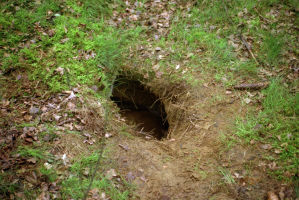
Another fox
den, this one in Europe.
Again, note the oval shape.
Maryland Fox den made from
groundhog hole.
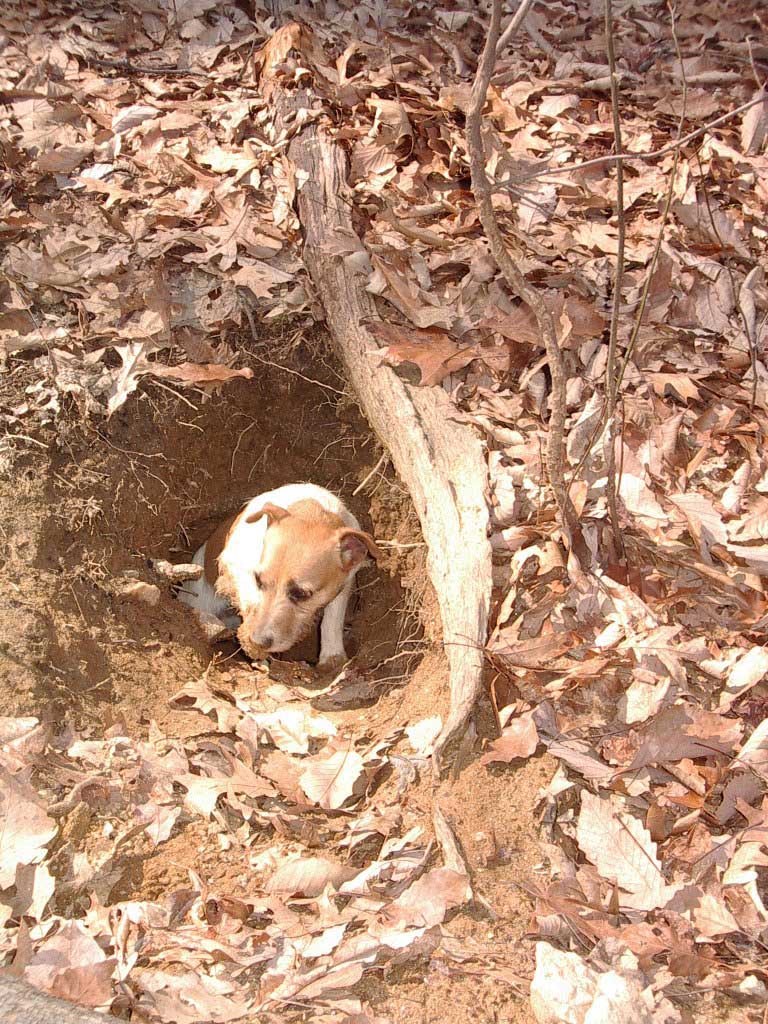 Jack Russell
exiting Virginia fox den. Two fox were bolted from this
den. The picture below this one is the same den, but the
entrance hole.
Jack Russell
exiting Virginia fox den. Two fox were bolted from this
den. The picture below this one is the same den, but the
entrance hole.
.
